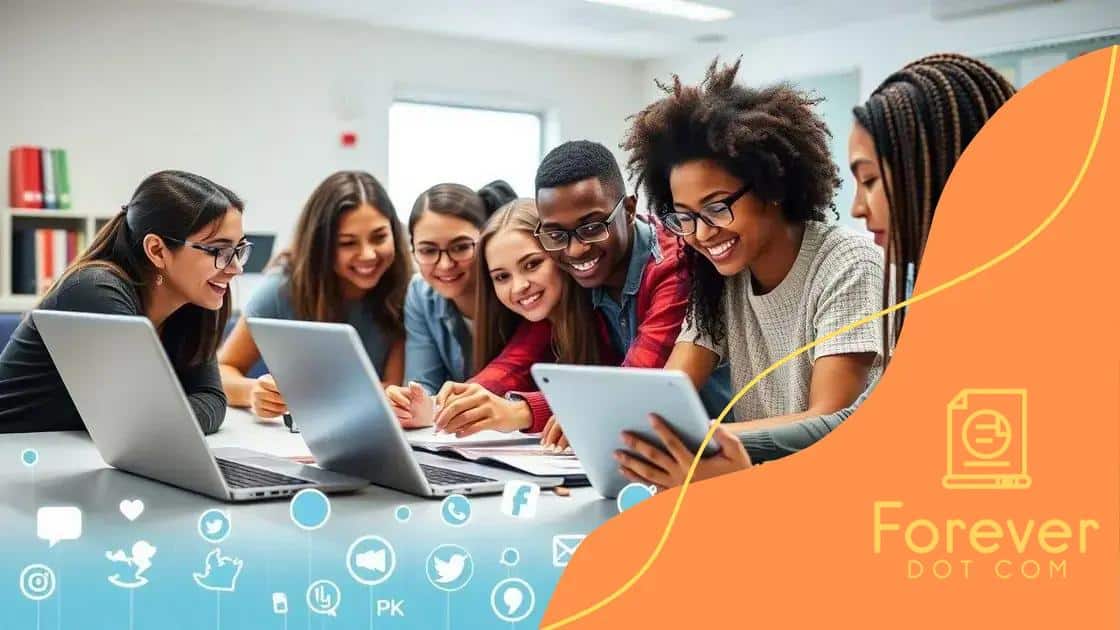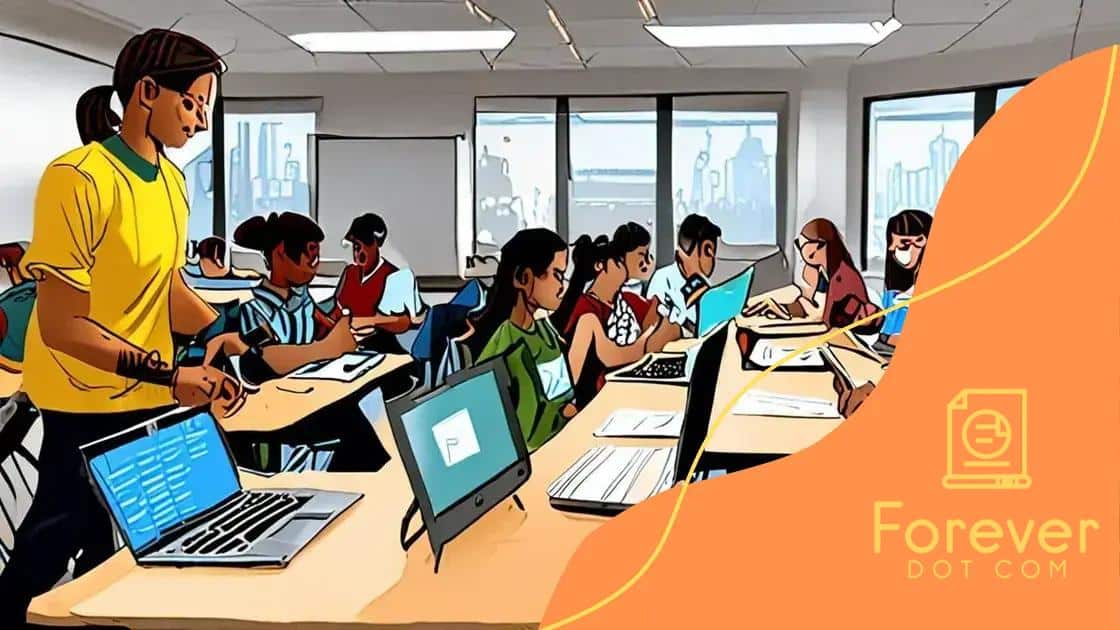Using social media for educational collaboration and learning

Using social media for educational collaboration enhances communication, promotes teamwork, and allows for resource sharing, while also requiring clear guidelines and monitoring to address challenges like privacy and distractions.
Using social media for educational collaboration and learning opens up new pathways for students and teachers alike. Have you ever wondered how platforms like Facebook or Twitter can complement traditional education methods? In this article, we will delve into the ways these tools can foster collaboration and enhance learning outcomes.
Benefits of social media in education
Discovering the benefits of social media in education is crucial for modern learning. This powerful tool can enhance educational experiences for both students and teachers.
Improved Communication
Social media allows for easy communication between students and teachers. It bridges gaps and fosters a collaborative environment. When educators engage with students through platforms like Facebook or Twitter, they promote open dialogues.
Engaging Learning Experiences
Using social media can create engaging learning experiences. Students can share resources, participate in discussions, and collaborate on projects. These platforms encourage creativity and innovation in learning.
- Access to diverse viewpoints
- Encouragement of critical thinking
- Instant feedback from peers and educators
Moreover, social media encourages students to take ownership of their learning. They can explore topics of interest and connect with experts worldwide. This aids in developing their research skills and enriching their knowledge base.
Building a Sense of Community
Another significant advantage is the sense of community it creates. Students can interact with classmates outside the classroom, building relationships. This social interaction is vital for emotional support and group learning.
Additionally, it fosters a supportive network where students can share achievements and challenges. A positive online community can enhance students’ confidence and motivation.
- Sharing success stories
- Providing peer support
- Encouraging collaborative projects
As technology continues to evolve, the role of social media in education will likely expand. Embracing these changes can lead to improved outcomes for learners worldwide. Social media’s benefits for education are immense, paving the way for innovative teaching methods and enriched learning experiences.
Popular platforms for educational collaboration
Understanding the popular platforms for educational collaboration is essential for both teachers and students. These tools enhance learning and make collaboration seamless.
Google Classroom
One of the most widely used platforms is Google Classroom. This user-friendly tool allows educators to create, distribute, and grade assignments easily. Students can access materials, submit work, and receive feedback all in one place.
Microsoft Teams
Another effective platform is Microsoft Teams. It offers chat, video calls, and file sharing, allowing students to work together in real-time. With its integration of Office 365, it serves as a comprehensive workspace for educational tasks.
- Facilitates group work
- Supports video conferences
- Integrates with various applications
Both platforms promote engagement and interactive learning. However, there are other valuable tools available as well. Platforms like Slack and Edmodo provide distinct features tailored for educational use.
Slack
Slack is known for its effective communication capabilities. It allows students to create channels based on projects or subjects. This organization helps keep discussions focused.
Edmodo
Edmodo serves as a social learning platform. Students can connect with their peers and teachers, share resources, and participate in discussions, fostering a community of learning.
As you explore these platforms, consider your specific needs. The right tool can enhance student collaboration and create a dynamic learning environment.
Real-life examples of collaborative learning

Exploring real-life examples of collaborative learning can shed light on effective educational practices. These examples help illustrate how students can benefit from teamwork and shared knowledge.
Project-Based Learning
One prominent method is project-based learning. In this approach, students work together on projects that involve hands-on tasks. For instance, a group of students may create a community garden. They must collaborate to research, plan, and execute the project.
Peer Teaching
Peer teaching is another effective strategy. In classrooms, students take turns teaching each other. This method reinforces their understanding of the material and builds communication skills. For example, in a science class, students can explain concepts like the water cycle to their classmates.
- Encourages active participation
- Boosts confidence in sharing knowledge
- Promotes responsibility and accountability
Coding clubs are also a fantastic example of collaborative learning. Students gather to work on coding projects together. As they solve problems, they learn from each other. This creates an environment where students feel supported and inspired.
Online Collaborative Platforms
Moreover, many schools use online platforms for collaborative learning. Tools like Google Docs and Trello enable students to work on assignments remotely, making collaboration easier. They can share ideas, give feedback, and track their progress as a team.
Overall, these examples showcase the effectiveness of collaborative learning. When students work together, they not only deepen their understanding but also develop essential skills for their future.
Tips for effective use of social media in classrooms
Implementing effective use of social media in classrooms can greatly enhance student engagement and learning. Teachers can integrate these platforms meaningfully into their lessons.
Set Clear Guidelines
First, it’s important to establish clear guidelines for social media use. This helps maintain a positive and focused environment. Teachers should outline acceptable behaviors, privacy considerations, and the purpose of using social media in class.
Encourage Participation
Next, educators can use social media to encourage participation. Platforms like Twitter or Instagram can serve as tools for students to share thoughts on class topics. By posing questions or challenges on these platforms, teachers can foster open discussions beyond the classroom.
- Pose weekly discussion topics
- Encourage students to share relevant articles
- Use polls to gather opinions and feedback
Collaboration is another key area. Using social media, students can work together on projects, share resources, and provide feedback to each other. This collaborative approach not only enhances learning but also builds community among students.
Monitor and Engage
Teachers should regularly monitor interactions on these platforms. Engaging with students during their social media discussions can show that their contributions are valued. This also helps keep conversations on track and focused on learning outcomes.
Lastly, it’s essential to assess the impact of social media use. Teachers should reflect on which strategies work best and make adjustments as needed. Asking for student feedback can provide valuable insights into their experiences with social media in class.
Challenges and solutions in educational social media use
Understanding the challenges and solutions in educational social media use is essential for effective integration in classrooms. While these platforms offer great opportunities, they also present certain obstacles that educators must navigate.
Privacy Concerns
One major challenge is the privacy concerns associated with social media. Students’ personal data may be exposed, raising questions about safety and confidentiality. To mitigate these risks, teachers should educate students on proper privacy settings and the importance of safeguarding personal information.
Distraction and Misuse
Additionally, social media can be a source of distraction for students. They may find it difficult to focus on academic tasks when notifications and other social interactions are constantly at their fingertips. To address this, educators can establish specific times for social media use during lessons, ensuring a balance between learning and engagement.
- Set clear expectations for use
- Incorporate focused activities
- Promote digital citizenship education
Another concern is the potential for cyberbullying, which can have harmful effects on students’ mental health. Schools must encourage a respectful online culture and be proactive in addressing any reported incidents. Creating an environment where students feel safe to speak up is vital for a positive educational experience.
Digital Literacy Skills
Moreover, not all students have the same level of digital literacy skills. Some may struggle to navigate social media effectively for educational purposes. Educators should provide guidance and training on using these platforms responsibly.
Through workshops or tutorials, teachers can help students develop necessary skills to use social media wisely and effectively.
In conclusion, using social media for educational purposes can greatly enhance collaboration and learning. While there are challenges such as privacy concerns, distractions, and varying digital skills, solutions are available to make social media a valuable tool in the classroom. By setting clear guidelines and teaching responsible use, educators can create a positive and effective learning environment. Embracing the right strategies allows students to benefit from the many advantages social media offers while minimizing potential risks. It’s an exciting opportunity to innovate education!
FAQ – Frequently Asked Questions about Using Social Media in Education
What are the main benefits of using social media in classrooms?
Social media promotes collaboration, enhances communication, and fosters a sense of community among students and teachers.
How can teachers ensure students use social media responsibly?
Teachers should establish clear guidelines, educate students on privacy, and promote digital citizenship to encourage responsible use.
What are common challenges in using social media for education?
Challenges include privacy concerns, distractions, and the potential for cyberbullying, which require careful management.
How can social media be integrated into projects effectively?
Teachers can encourage students to use social media for project collaboration, sharing resources, and presenting their work to a wider audience.






